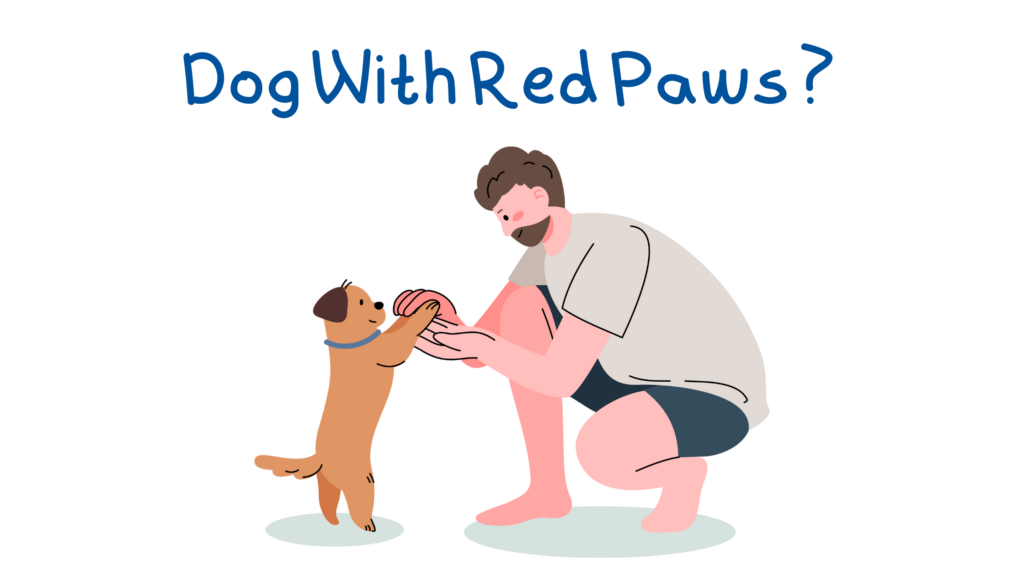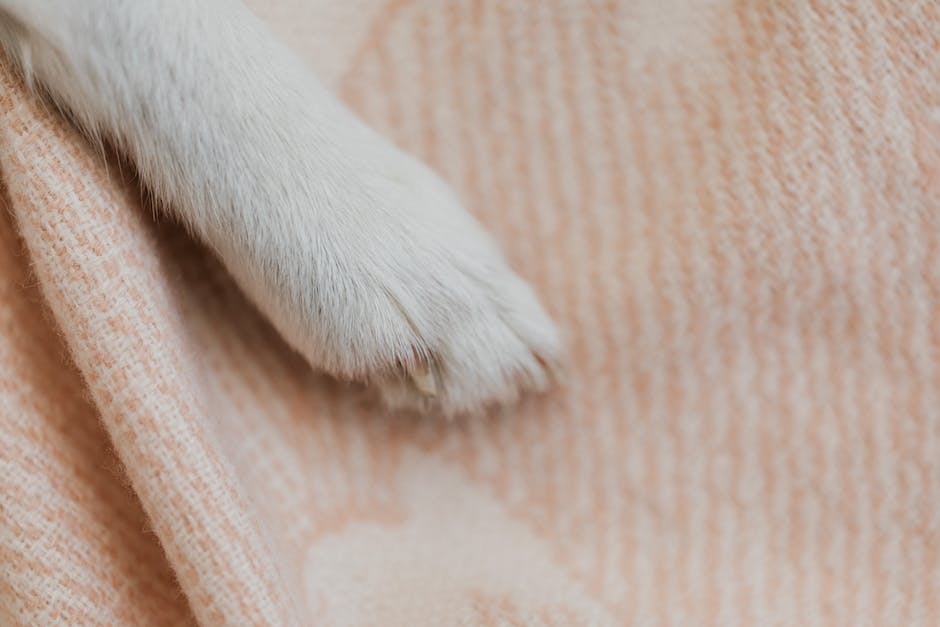Owning a dog calls for more than just unconditional love and belly rubs. It requires a keen eye and an informed mind to identify signs that your dog could be experiencing discomfort. A common example is when your dog’s paws are red.
While the most common reason for dogs with red paws is allergies, it’s important to know what your dog may be allergic to or if there is something more serious like an infection that may need to be treated by a vet.
If you’re looking for a better understanding why a dog might suffer from red paws and what steps can be done to treat it, then keep reading!

Common Causes of Red Paws in Dogs
If you notice your dog persistently licking, gnawing, or biting its paws it may cause them to appear red and inflamed. Several factors can lead to this condition also known as pododermatitis.
Allergies
The most prevalent reason for dogs’ red paws is allergies. Dogs can develop allergies to certain ingredients in their diet, like chicken, beef, dairy, or corn. Switching your pup’s diet to eliminate these ingredients can significantly improve their paw health.
Environmental allergens, such as seasonal pollens, molds, and dust mites, can also trigger allergic reactions leading to red paws. This can come from taking walks to even being in touch with products in your home like floor cleaners.
Infections and Pododermatitis
Pododermatitis is often linked to bacterial or fungal infections, such as yeast. Dogs with compromised immune systems or suffered from injuries are particularly vulnerable to these infections.
Injuries and Traumas
Minor injuries, such as cuts, blisters, or burns on the paws, can cause localized redness and swelling. Walking on hot pavement, stepping on sharp objects, or rough play can result in these injuries. While minor injuries will usually heal on their own over time, if a dog’s paw appears severely injured, take them to the vet so they can take a look.
Parasites
Parasites such as fleas, mites, or ticks are known to cause itching and irritation on a dog’s paws. If the dog chews or licks the affected area aggressively, their paws might turn red. Regular grooming and flea protection treatments can help in preventing this issue.
Observing a dog’s paw color can often provide helpful insights into their overall health and well-being. A common issue often spotted is that of red paws. Regular monitoring of your canine friend’s behavior and comfort level is crucial for their well-being. While mild cases can often be mitigated through preventive care or at-home treatments, seeing a veterinarian may become necessary in severe cases.

Will My Dog Act Differently With Red Paws?
Occasional reddening of paws might not be a cause for alarm. However, consistent, recurring, or prolonged redness is a clear sign that there could be underlying health problems needing your attention and possibly professional veterinary care.
Why Do Dog’s Paws Turn Red?
Firstly, it’s important to understand why a dog’s paws might turn red. The skin and pads of a dog’s paws are normally light pink or black depending on their breed, but they can turn red due to various reasons. Some common causes include allergies to certain food or environmental factors, yeast infections, mites or other parasites, and excessive licking or chewing that could be indicative of anxiety or boredom.
Impact of Red Paws on a Dog’s Health
Red paws can take a toll on a dog’s health if left unaddressed, stemming from mere discomfort to severe pain. When a dog’s paws are red and irritated, it may lead to excessive licking and chewing as dogs try to soothe the discomfort. This could potentially result in raw skin or open wounds, which puts the dog at risk for bacterial or yeast infections. Untreated redness can cause the paw pads to become thick and hard, resulting in a condition called hyperkeratosis.
In cases of allergies, the rest of the body may also be affected with symptoms such as redness, itchiness, and even diarrhea.
Behavioral Changes in Dogs with Red Paws
Red paws will not only impact a dog’s health but also its behavior. Dogs with red and irritated paws may exhibit a change in their demeanor, like becoming more withdrawn due to discomfort or pain. They may also constantly gnaw, lick, or bite at their paws as an attempt to alleviate discomfort.
The Significance of Prompt Veterinary Care
If your dog has chronic redness or discomfort, particularly in their paws, it’s a good sign they should be taken to the vet. Early detection and proper treatments can easily managed with a simple phone call.

How Vets Can Treat Dogs With Red Paws
Redness in a dog’s paws is a frequently dismissed yet common health concern. This seemingly harmless symptom could indicate a range of health problems ranging from a mere skin irritation to more serious conditions. If you’re dog seems to have chronic red paws or seems to be in extreme discomfort, here is vets can diagnose and treat them.
Physical Examinations
The first step that veterinarians typically take when they notice red paws in dogs is to perform a physical examination. As the pet owner, you might notice symptoms like constant licking, bite marks around the paws, or even limping. These symptoms often lead to the telltale signs of inflammation, redness, and discomfort. The vet will examine the paws closely for any signs of injury, swelling, or infection.
Allergy Tests
If the physical examination does not reveal any significant findings, the next step is allergy testing. This is because red paws are often caused by allergies. These allergies could be either food-related, environmental, or could result from a reaction to certain materials that the dog is interacting with daily. Skin tests or blood tests can be used for allergen specific IgE testing. Based on the findings, vets are then able to advise on the best plan to manage and treat the allergy.
Beyond the basic physical examination and allergy testing, there are other diagnostic tools and procedures that veterinarians can employ to get to the root cause of red paws in dogs. These could include:
- Skin scrapings
- Bacterial and fungal cultures
- Biopsy

Treatment and Prevention of Red Paws in Dogs
Treatment options for red paws in dogs can range from medications, ointments, to lifestyle changes, depending on the cause of the condition.
Medication and Topical Treatments
Topical creams or ointments containing hydrocortisone can help reduce inflammation and itchiness. Antifungal or antibacterial creams can also be applied if the redness is caused by an infection. For severe cases, oral medications such as antihistamines for allergies or antibiotics for infections might be prescribed by your vet.
More Physical Activity
Lifestyle changes can also help in treating and preventing red paws. If your dog is constantly licking their paws, it might be due to anxiety or boredom. Providing mental stimulation like toys or puzzles, or increasing physical activity can help keep them occupied.
Red Paws After Walks
If your dog’s paws become irritated after walks, they might be sensitive to salts or other chemicals used for de-icing in the winter, or hot asphalt in the summer. Using dog booties during walks can help protect their paws. Keeping your living area clean and free from potential irritants can also prevent red paws.
Changing Their Diet
For dogs with allergies, it may be helpful to monitor their diet. Food allergens such as certain proteins, grains, or additives can lead to inflammation and red paws. Consulting with a vet to help pinpoint any potential allergens and making necessary dietary changes can help.

Our fur babies communicate with us through different ways and sometimes those ways involve showing physical signs such as red paws. As responsible pet parents, it’s our job to effectively interpret and act upon these signs for the benefit of our dogs’ health and happiness. When noticing red paws in your dog it’s important to pay attention to their physical behavior. If you notice your dog displaying behaviors that make them not seem like themselves, it’s time to take them to the vet for a further exam and treatment.


